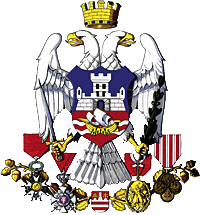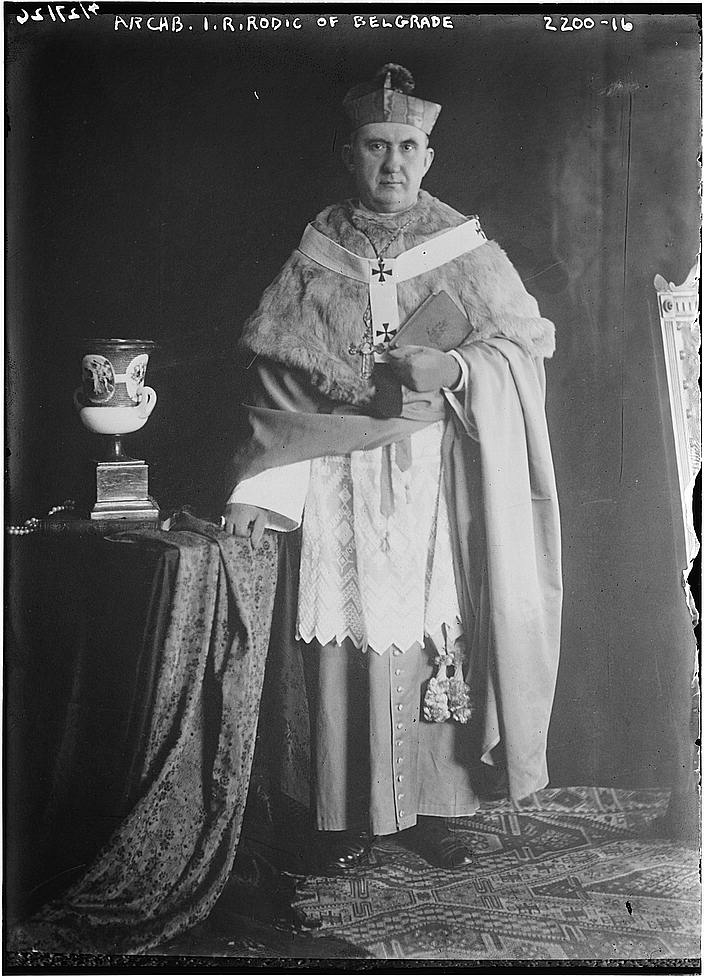|
Krunski Venac
Krunski Venac ( sr, Крунски Венац) is an urban neighborhood of Belgrade, the capital of Serbia. It is located in Belgrade's municipality of Vračar. In May 2021, the neighborhood was protected as the spatial cultural-historical unit. Location Krunski Venac is located along the ''Krunska'' street after which the neighborhood got its name (Serbian for "coronation street"), in the northern part of Vračar, stretches to the neighborhood of Kalenić. History 19th century At the corner of modern Krunska and Kneza Miloša streets, Jevrem Obrenović, brother of the ruling prince Miloš Obrenović, built the large house in the first half of the 19th century, and the spacious flower garden. Kept by his wife Tomanija, it was considered the most beautiful private garden in Belgrade at the time. The plants were imported from Turkey, Wallachia, Austria and France. In time, the area became known among the Belgraders as the "Corner at Mrs. Tomanija". The residence itself be ... [...More Info...] [...Related Items...] OR: [Wikipedia] [Google] [Baidu] |
List Of Belgrade Neighbourhoods And Suburbs
Belgrade, the capital city of Serbia, is divided into seventeen municipalities, of which ten are urban and seven suburban. In this list, each neighbourhood or suburb is categorised by the municipality in which it is situated. Six of these ten urban municipalities are completely within the bounds of Belgrade City Proper, while the remaining four have both urban and suburban parts. The seven suburban municipalities, on the other hand, are completely located within suburban bounds. Municipalities of the City of Belgrade are officially divided into local communities ( Serbian: месна заједница / ''mesna zajednica''). These are arbitrary administrative units which on occasion correspond to the neighbourhoods and suburbs located in a municipality, though usually they don't. Their boundaries often change as the communities merge with each other, split from one another, or change names, so the historical and traditional names of the neighbourhoods survive. In the majority ... [...More Info...] [...Related Items...] OR: [Wikipedia] [Google] [Baidu] |
Miloš Obrenović
Miloš, Milos, Miłosz or spelling variations thereof is a masculine given name and a surname. It may refer to: Given name Sportsmen * Miłosz Bernatajtys, Polish rower * Miloš Bogunović, Serbian footballer * Miloš Budaković, Serbian footballer * Miloš Ćuk, Serbian water polo player, Olympic champion * Miloš Dimitrijević, Serbian footballer * Miloš Holuša, Czech race walker * Miloš Jojić, Serbian footballer * Miloš Korolija, Serbian water polo player * Miloš Krasić, Serbian footballer * Miloš Marić, Serbian footballer * Miloš Milošević, Croatian swimmer * Miloš Milutinović, Serbian footballer and manager * Miloš Nikić, Serbian volleyball player * Miloš Ninković, Serbian footballer * Miloš Pavlović (racing driver), Serbian racing driver * Milos Raonic, Montenegrin-born Canadian tennis player * Miloš Stanojević (rower), Serbian rower * Miloš Šestić, Serbian footballer * Miloš Teodosić, Serbian basketball player * Miloš Terzić, Serbian vo ... [...More Info...] [...Related Items...] OR: [Wikipedia] [Google] [Baidu] |
Interbellum
In the history of the 20th century, the interwar period lasted from 11 November 1918 to 1 September 1939 (20 years, 9 months, 21 days), the end of the First World War to the beginning of the Second World War. The interwar period was relatively short, yet featured many significant social, political, and economic changes throughout the world. Petroleum-based energy production and associated mechanisation led to the prosperous Roaring Twenties, a time of both social mobility and economic mobility for the middle class. Automobiles, electric lighting, radio, and more became common among populations in the developed world. The indulgences of the era subsequently were followed by the Great Depression, an unprecedented worldwide economic downturn that severely damaged many of the world's largest economies. Politically, the era coincided with the rise of communism, starting in Russia with the October Revolution and Russian Civil War, at the end of World War I, and ended with the rise ... [...More Info...] [...Related Items...] OR: [Wikipedia] [Google] [Baidu] |
Co-cathedral Of Christ The King, Belgrade
The Co-cathedral of Christ the King ( sh, Konkatedrala Krista Kralja) is a Catholic place of worship located in ''Krunska 23'', in the city center of Belgrade, Serbia. It is the oldest extant Catholic church in the city south of the Sava and the Danube rivers, and was built between 1924 and 1988, the cathedral of the Archdiocese of Belgrade. History The Co-Cathedral of Christ the King is the oldest catholic place of worship of Belgrade. Its construction was undertaken only in 1924: in fact, since 1914 the negotiations were taking place between the Holy See and the Serbian government for the construction of a church. The new temple, dedicated to St. Ladislaus, was solemnly consecrated by the Apostolic Nuncio Pellegrinetti December 7, 1924 and elevated to the rank of cathedral of the newly Archdiocese of Belgrade, which was the first Archbishop Ivan Rafael Rodić. In 1926, the church was expanded and reached its current size, was also dedicated to Christ the King next year, wer ... [...More Info...] [...Related Items...] OR: [Wikipedia] [Google] [Baidu] |
Ivan Rafael Rodić
Archbishop Ivan Rafael Rodić, O.F.M. (also , it, Giovanni Raffaele Rodic; June 15, 1870 – May 10, 1954) was a Croatian Franciscan prelate, who served as the first Archbishop of the Roman Catholic Archdiocese of Belgrade-Smederevo between 1924 and 1936. Biography Rodić was born on June 15, 1870, in the village of Nurkovac, at the time in the Kingdom of Croatia-Slavonia. As a Franciscan, he graduated from the Vienna University of Theology and started teaching theology in Baja, Hungary in 1893, where he remained until 1898. He became the Abbot of the Franciscan monastery in Vienna, and the provincial minister of several monasteries in Croatia. Between 1881 and 1884, he was the provincial of the Province of St. John of Capistrano that included Slavonia, Syrmia and much of southern Hungary. In 1884, Rodić in his capacity as provincial declined the request of Ivan Antunović to help start a newspaper for the Bunjevci Croats in Bačka, fearing opposition from higher authoriti ... [...More Info...] [...Related Items...] OR: [Wikipedia] [Google] [Baidu] |
Roman Catholic Archdiocese Of Belgrade
The Catholic Archdiocese of Belgrade ( la, Archidioecesis Belogradensis; sh, Beogradska nadbiskupija; hu, Belgrádi főegyházmegye) is an archdiocese located in the city of Belgrade in Serbia. History In order to regulate status of local Catholic Church, the government of the Kingdom of Serbia concluded official Concordat with Holy See on 24 June 1914. By the Second Article of Concordat, it was decided that regular Catholic Archdiocese of Belgrade shall be created. Because of the breakout of the First World War, those provisions could not be implemented, and only after 1918 were new arrangements made: * October 29, 1924: Promoted as Archdiocese of Belgrade * December 16, 1986: Promoted as Metropolitan Archdiocese of Belgrade United Titles * Smederevo (Since December 23, 1729) Leadership * Bishops of Beograd ** Bishop Jozef Ignác de Vilt (22 December 1800 – 26 August 1806) ** Bishop Stefan Cech (26 September 1814 – 8 January 1821) ** Bishop Venceslao Soic (23 Decembe ... [...More Info...] [...Related Items...] OR: [Wikipedia] [Google] [Baidu] |
Politika
''Politika'' ( sr-Cyrl, Политика; ''Politics'') is a Serbian daily newspaper, published in Belgrade. Founded in 1904 by Vladislav F. Ribnikar, it is the oldest daily newspaper still in circulation in the Balkans. Publishing and ownership ''Politika'' is published by Politika novine i magazini (PNM), a joint venture between Politika AD and ''East Media Group''. The current director of PNM is Mira Glišić Simić. PNM also publishes: *''Sportski žurnal'' *'' Politikin zabavnik'' *'' Svet kompjutera'' *''Ilustrovana politika'' *''Bazar'' Editorial history *Vladislav F. Ribnikar (1904–1915) *Miomir Milenović i Jovan Tanović (1915–1941) *Živorad Minović (1985–1991) *Aleksandar Prlja (1991–1994) *Boško Jakšić (1994) *Dragan Hadži Antić (1994–2000) *Vojin Partonić (2000–2001) *Milan Mišić (2001–2005) *Ljiljana Smajlović (2005–2008) *Radmilo Kljajić (2008) *Dragan Bujošević (2008–2013) *Ljiljana Smajlović (2013–2016) *Žarko Rakić (2016- ... [...More Info...] [...Related Items...] OR: [Wikipedia] [Google] [Baidu] |
Queen Draga
Queen or QUEEN may refer to: Monarchy * Queen regnant, a female monarch of a Kingdom ** List of queens regnant * Queen consort, the wife of a reigning king * Queen dowager, the widow of a king * Queen mother, a queen dowager who is the mother of a reigning monarch Arts and entertainment Fictional characters * Queen (Marvel Comics), Adrianna "Ana" Soria * Evil Queen, from ''Snow White'' * Red Queen (''Through the Looking-Glass'') * Queen of Hearts (''Alice's Adventures in Wonderland'') Gaming * Queen (chess), a chess piece * Queen (playing card), a playing card with a picture of a woman on it * Queen (carrom), a piece in carrom Music * Queen (band), a British rock band ** ''Queen'' (Queen album), 1973 * ''Queen'' (Kaya album), 2011 * ''Queen'' (Nicki Minaj album), 2018 * ''Queen'' (Ten Walls album), 2017 * "Queen", a song by Estelle from the 2018 album ''Lovers Rock'' * "Queen", a song by G Flip featuring Mxmtoon, 2020 * "Queen", a song by Jessie J from the 2018 al ... [...More Info...] [...Related Items...] OR: [Wikipedia] [Google] [Baidu] |
Telephone Exchange
A telephone exchange, telephone switch, or central office is a telecommunications system used in the public switched telephone network (PSTN) or in large enterprises. It interconnects telephone subscriber lines or virtual circuits of digital systems to establish telephone calls between subscribers. In historical perspective, telecommunication terms have been used with different semantics over time. The term ''telephone exchange'' is often used synonymously with ''central office'', a Bell System term. Often, a ''central office'' is defined as a building used to house the inside plant equipment of potentially several telephone exchanges, each serving a certain geographical area. Such an area has also been referred to as the exchange or exchange area. In North America, a central office location may also be identified as a ''wire center'', designating a facility to which a telephone is connected and obtains dial tone. For business and billing purposes, telecommunication carriers defi ... [...More Info...] [...Related Items...] OR: [Wikipedia] [Google] [Baidu] |
Bulevar Kralja Aleksandra
Bulevar kralja Aleksandra ( sr-Cyrl, Булевар краља Александра, "King Alexander Boulevard") is the longest street entirely within the urban limits of Serbian capital Belgrade, with length of 7.5 kilometers. Known for decades after World War II as ''Bulevar Revolucije'' ( sr-Cyrl, Булевар Револуције, "Boulevard of the Revolution"), it is so distinct in the Belgraders' hearts and minds that they simply refer to it as the Bulevar ( sr-Cyrl, Булевар, "Boulevard), although there are 20 boulevards in Belgrade. Location Due to its length, Bulevar stretches through four out of eight urban municipalities in the old section Belgrade: Stari Grad, Palilula, Vračar and Zvezdara, in which the main part of the Bulevar is located. Starting at the Square of Nikola Pašić, it goes for the most part in a south-east direction, curving only near the end, in the neighborhood of Mali Mokri Lug, after which the Bulevar extends into the road of ''Smederev ... [...More Info...] [...Related Items...] OR: [Wikipedia] [Google] [Baidu] |




.jpg)
